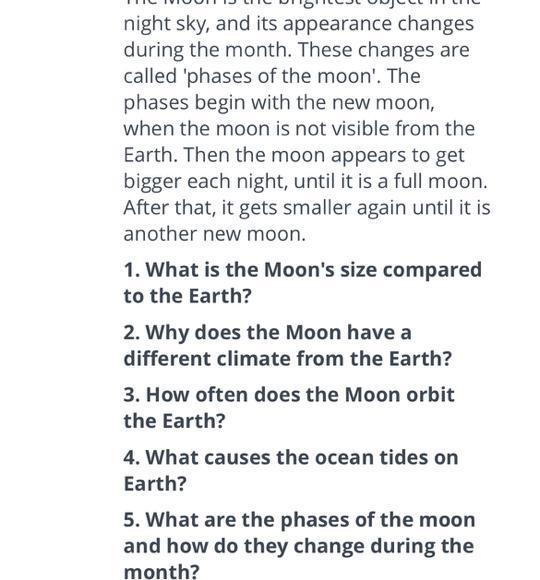Предмет: Английский язык,
автор: dfedeneva75
Moon also affects the way we measure
time. The first day of the week,
Monday, is named after the Moon.
There are twelve lunar months in a
year, and the word 'month' comes from
'moon'.
The Moon is the brightest object in the
night sky, and its appearance changes
during the month. These changes are
called 'phases of the moon'. The
phases begin with the new moon,
when the moon is not visible from the
Earth. Then the moon appears to get
bigger each night, until it is a full moon.
After that, it gets smaller again until it is
another new moon.
1. What is the Moon's size compared
to the Earth?
2. Why does the Moon have a
different climate from the Earth?
3. How often does the Moon orbit
the Earth?
4. What causes the ocean tides on
Earth?
5. What are the phases of the moon
and how do they change during the
month? Дам 20 баллов!!
Приложения:

Ответы
Автор ответа:
0
Ответ:
Certainly, here are the answers:
1. The Moon's size is smaller compared to the Earth.
2. The Moon's lack of atmosphere leads to a different climate compared to Earth.
3. The Moon orbits the Earth approximately once every 27.3 days.
4. The ocean tides on Earth are primarily caused by the gravitational pull of the Moon.
5. The phases of the moon are: new moon (not visible), waxing crescent, first quarter, waxing gibbous, full moon, waning gibbous, last quarter, waning crescent, back to new moon. The moon appears to change from not visible (new moon) to a full circle (full moon) and then back to not visible again in a cycle that takes about 29.5 days.
Похожие вопросы
Предмет: Қазақ тiлi,
автор: vasilisashevkunova
Предмет: Химия,
автор: revinstanislav7
Предмет: Українська мова,
автор: rliza4104
Предмет: Обществознание,
автор: podlesnovaolga06
Предмет: Биология,
автор: Аноним